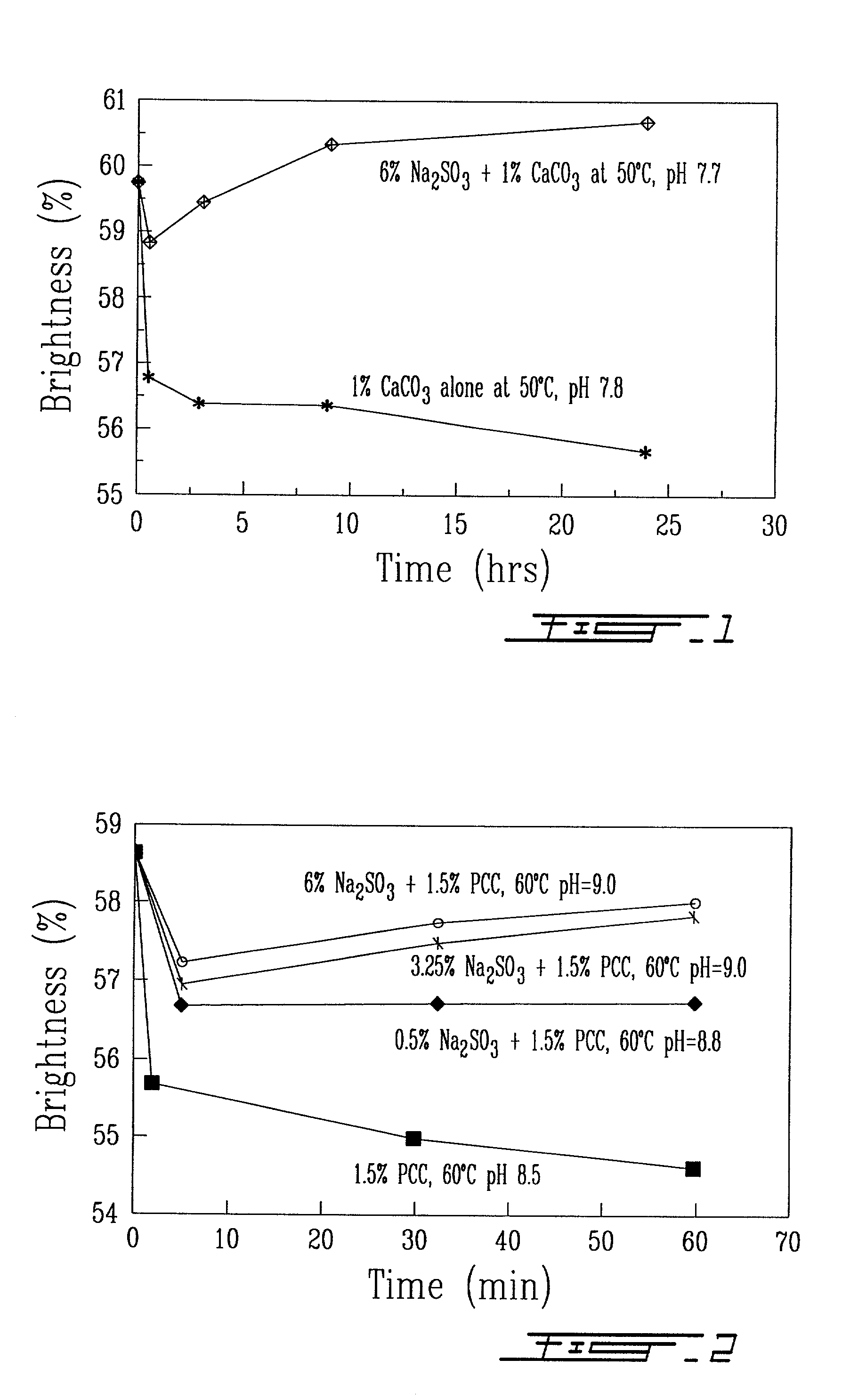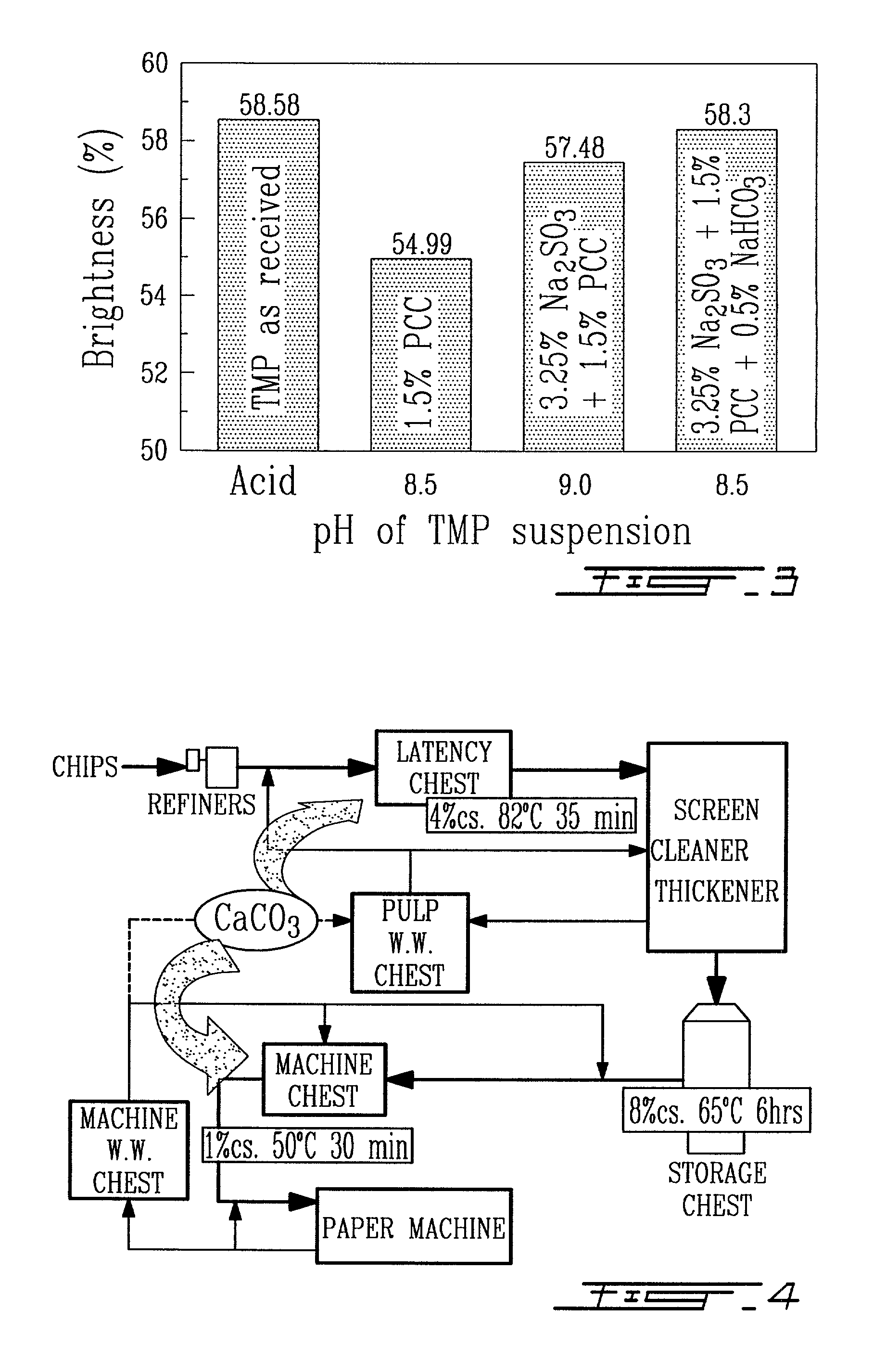Method for reducing alkaline darkening of mechanical pulp containing a calcium carbonate filler
a technology of calcium carbonate filler and mechanical pulp, which is applied in the field of preventing alkaline darkening of mechanical pulp containing calcium carbonate filler, can solve the problems of paper cannot be produced in acidic medium using, paper cannot be graded according to method, and the brightness loss of 1 to 5 points is often experienced. , to achieve the effect of preventing the darkening of mechanical pulp
- Summary
- Abstract
- Description
- Claims
- Application Information
AI Technical Summary
Benefits of technology
Problems solved by technology
Method used
Image
Examples
examples
[0041]The following examples help to more fully understand the method of the present invention and carry out the process. These examples should be taken as illustrative and are not meant to limit the scope of the invention.
example i
[0042]This example was tailored to show how a commercial thermomechanical pulp (TMP) furnish blended with calcium carbonate filler can be successfully treated with sodium sulphite, according to the instant invention, to reduce darkening of the furnish. The TMP furnish, received from an Eastern Canadian pulp mill, was mixed with 1%, by weight, calcium carbonate filler. One part was treated with sodium sulphite while the other part was not. The results of the experiment, shown in FIG. 1, indicate that the sample without sodium sulfite began to darken immediately, losing three brightness points after 30 minutes at 50° C. The sulphite containing sample lost only one point of brightness in that period and thereafter, surprisingly, not only did it regain its starting brightness but surpassed it one additional point. The sample without sodium sulfite continued to darken in the subsequent time period losing a total of four brightness points.
example ii
[0043]An acid washed TMP furnish was slurried in water with 1.5% calcium carbonate (PCC) based on o.d. weight of furnish in the presence and absence of sodium sulphite. Prior to chemical addition, an acid washing was used to remove metal ions from TMP. The original brightness of the TMP furnish, as received from the mill, was 57.8%. The pH of the blend was adjusted to 7.5 with sodium phosphate. The results, shown in Table 1, indicate that the sample without sulphite darkened quickly losing a total of 6.2 brightness points while the sulphite-containing sample lost only two points.
[0044]
TABLE 1Acid washed TMP containing PCC treated with or withoutsodium sulphite.SodiumScatteringAbsorptionsulphiteBrightness,Coeff.Coeff%Treatment%m2 / kgm2 / kg0as received57.8050.482.3401.5% PCC, pH 7.5,51.5650.624.5375° C., 3 hrs21.5% PCC, pH 7.5,55.7549.903.3175° C., 3 hrs
PUM
| Property | Measurement | Unit |
|---|---|---|
| pH | aaaaa | aaaaa |
| pH | aaaaa | aaaaa |
| temperature | aaaaa | aaaaa |
Abstract
Description
Claims
Application Information
 Login to View More
Login to View More - R&D
- Intellectual Property
- Life Sciences
- Materials
- Tech Scout
- Unparalleled Data Quality
- Higher Quality Content
- 60% Fewer Hallucinations
Browse by: Latest US Patents, China's latest patents, Technical Efficacy Thesaurus, Application Domain, Technology Topic, Popular Technical Reports.
© 2025 PatSnap. All rights reserved.Legal|Privacy policy|Modern Slavery Act Transparency Statement|Sitemap|About US| Contact US: help@patsnap.com



